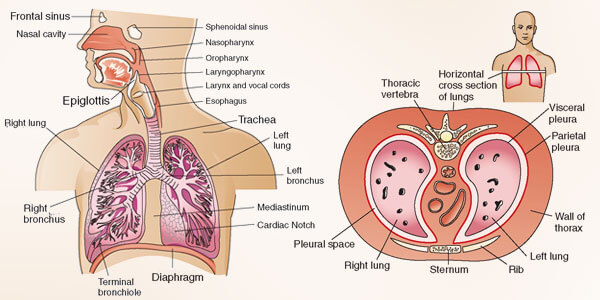How Does The Respiratory System Work To Sustain Life
Respiration is one of the most important processes which take place in an organism’s body in order to sustain life. Various organs combine together to form the respiratory system which in turn helps organisms replenish their supplies of oxygen. In humans, this extraordinary system is extremely well-developed. The following discussion explains the answer to the question: “How does the respiratory system work in human body?”

Replenishing Oxygen Supplies:
The main purpose served by the respiratory system is to provide fresh supplies of oxygen to the body both during the day as well as the night when an organism is asleep. This system, therefore, works involuntarily. Apart from receiving fresh oxygen from the air, this system also helps organisms in getting rid of the by-product of respiration, that is, carbon dioxide. In case this compound accumulates in the body, it can prove to be extremely harmful. A person can faint, experience brain damage or even loose their life due to prolonged carbon dioxide accumulation.
Inhaling and Exhaling:
How does the respiratory system work? It begins by the process of inhaling and exhaling. The main air passages between the surrounding air and the human body can be through the nostrils as well as through the mouth. Air enters through these passages and then moves through other components of the system including the nasal cavity, pharynx, larynx, trachea, bronchi and finally into the bronchioles. Fresh air moves inside in this order while the used up air leaves in the reverse order.
The processes of inhaling and exhaling air are supported by the diaphragm. It is a muscular band which is shaped in the form of a dome. The contraction and relaxation of this muscle are involuntary and help in the entry as well as the release of air from a human’s body. When it contracts, the diaphragm flattens in order to let the chest cavity expand. In this way, more space is created for the inhaled air. On the other hand, in order to force the used up air out, the diaphragm contracts during the process of exhalation.
In this way, the exchange of air between the human body and the surrounding air keeps the process of respiration functioning properly.
Purification of Air
In order to sustain life, it is important to keep the body protected against harmful external agents. During inhalation, it is very easy for foreign bodies, such as dust and smoke, to enter the body and damage delicate internal organs. In particular, the organs of the respiratory system themselves can be damaged and get functionally affected as a consequence. For this purpose, a layer of mucous is present around the walls of the respiratory tract. It is a slimy and sticky substance which traps small foreign agents that enter the tract. The air passages are also lined by small hair which trap dust effectively.
Optimizing the Functionality:
The respiratory system in humans works most efficiently since its structure is optimized for its functionality. The surface area to volume ratio of the lungs is large owing to the presence of multiple alveoli. These are small air-filled sacs surrounded by blood capillaries. This arrangement allows an effective and efficient exchange of air between the lungs and the blood.
In this way, this important system sustains life through its outstanding working mechanism, protection against diseases and infections, and optimization of functionality.


